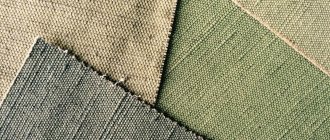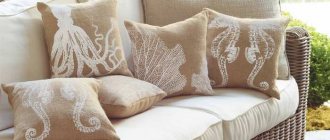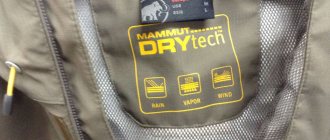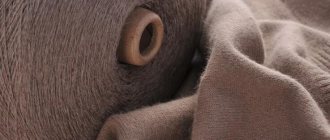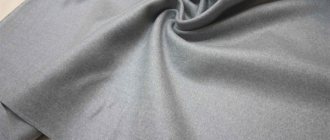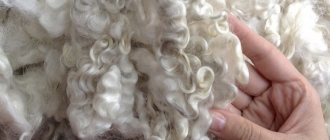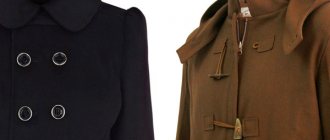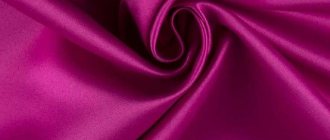What type of fabric is this?
Canvas is a durable, dense material made from synthetic and natural fibers. Same on both sides. Outwardly similar to tarpaulin, but soft, comfortable, pleasant to the touch.
Tarpaulin
Strength and wear resistance: an overview of the properties of tarpaulin fabric
more details
The fabrics are made on looms using the method of double weaving of warp and longitudinal threads. The outer layers are made of synthetics - polyester with the addition of nylon. The main (inner) layer is made of polyester and cotton or linen fibers.
Canvas colors
Untreated (harsh) canvases are impregnated with compounds that repel water and dirt. Impregnations are made on the basis of wax and Teflon. Materials are painted in natural or bright colors. Drawings are applied to the surface. Workwear and sporting goods are made from canvas. Used to decorate rooms, make covers, awnings.
Almost no care
Caring for things made from new generation canvas is very simple. The only precaution that should be taken in this case is not to damage the Teflon impregnation, since its destruction will worsen many of the protective qualities of this fabric. If a stain appears on the product, it can be easily washed with a sponge moistened with water or soapy water. During long-term use, both outdoors and indoors, the canvas product must be periodically shaken out or vacuumed (using only a soft brush).
Washing is carried out if necessary, using an economical machine mode and warm water. This fabric dries instantly and does not form creases. If there is a desire or need to smooth it out, then you should use a stream of steam or a cold iron.
Origin story
The name of the fabric comes from the Latin word canuabis - hemp. The ancient Greeks and Romans made durable materials from hemp. The predecessor of canvas is considered to be a material for sails.
The canvas was made from hemp and impregnated with beeswax. Later, flax and cotton were used simultaneously with hemp. Durable materials repelled moisture and did not deteriorate in sea water.
From the late 15th to early 19th centuries, canvas was a strategic commodity. After the advent of steamships, its importance decreased. The material was used to make things for the navy, army, peasant clothing, and luggage covers. After the advent of synthetics, durable waterproof items are made from mixed fabrics protected with impregnations.
What is meant by the expression “send to the canvas”?
Now we can begin to explain the meaning of the slang expression “send to the canvas.” It denotes a powerful blow (a series of blows) of a fighter, which led to the opponent falling onto the surface of the ring or cage. This phrase is equivalent in meaning to the expressions “knock down” and “knock out.” In turn, knockdown and knockout represent specific conditions of an athlete. The fundamental difference between these states is the strength of the negative impact on the athlete’s body and the duration of the fighter’s stay on the octagon (ring) surface in such a state of health.
The referee counts the time. If a fighter gets up after a missed blow before the referee says “nine”, the athlete is considered to have been knocked down. A knockout is recorded when one of the opponents, having fallen after a blow, does not get into a fighting stance after the “ten” count. Thus, “send to the canvas” means delivering a powerful blow (a series of blows), as a result of which the opponent falls to the floor and finds himself at least knocked down, and at most, knocked out. It should be understood that in this context we do not mean a technical knockout, but only a combat knockout (otherwise known as a “clean knockout”).
Pros and cons of fabric
Advantages:
- Wear resistance, strength, durability.
- Repels moisture and dirt. Reliably protects from snow and rain.
- Despite the high density, it is soft, pleasant to the touch, and comfortable.
- Lets air through.
- Just take care. Does not wrinkle, dries quickly, and is easy to clean.
- Does not deform.
- Doesn't roll down.
- No puffs are formed.
- Paints well.
- Does not allow light to pass through.
- Doesn't fade.
- It ages beautifully when worn.
Flaws:
- Low elasticity.
- When washing, the impregnation is washed out.
- Due to low hygroscopicity, it is suitable only for outerwear.
- Impregnations are harmful to allergy sufferers.
Canvas
Canvas curtains
Canvas curtains have recently become increasingly popular and in demand.
This is not surprising, because their appearance and performance characteristics are amazing, they perfectly complement the overall design of the room, and allow you to hide everything that happens in the room from prying eyes. Canvas is a modern fabric made of cotton with the addition of synthetic fibers; it has several layers. Thanks to the unique weaving, the material is wear-resistant, durable and dense.
In the Evrika Home online store you can buy canvas curtains at an affordable price. We have a large selection of colors that are sure to please even the most selective buyer. If you do not find a suitable set of curtains in the catalog, we will be happy to accept an application for custom tailoring. You will receive exactly the products that will meet your preferences and concepts of beauty.
Features of canvas curtains
Despite the simple design and the absence of patterns on the canvas, canvas curtains look great in the interior; they will harmoniously complement any style, and also create comfort and privacy. These products have the following advantages:
1. Wear resistance. The dense, unique weaving of fibers gives the fabric special strength and wear resistance; the curtains will look beautiful and neat for many years.
2. Immunity to UV rays. Even with constant contact with direct sunlight, the material will not fade or lose color brightness.
3. Air permeability. By closing the window with curtains, fresh air will still penetrate into the room; the fabric allows air to pass through perfectly without interfering with ventilation.
4. Create an atmosphere of privacy. Curtains made of canvas fabric perfectly shade the room; extraneous light from the street will not interfere or irritate. This is very important for residents of megacities, where even at night there is a large flow of cars and store signs are brightly lit.
5. Water and dirt repellent properties. The curtains are impregnated with a special substance that reliably protects the fabric from excessive dust and stains.
6. Optimal cost. Curtains made from this fabric are reasonably priced; you can purchase them in our online store at the best prices.
The canvas material looks rough, which is why buyers often get the false impression that it requires special care. In fact, curtains made from this fabric are very easy to care for; they do not need to be washed often; it is enough to vacuum the fabric when it becomes dusty. And if stains occur, you can use a sponge with detergent to selectively wash the fabric.
If there is a need to completely wash the products, this can be done in an automatic washing machine at a temperature of no more than 40 degrees. After this, it is recommended to iron the curtains to give them a neat appearance.
We are always ready to help and answer all your questions. To do this, contact our online consultant to learn more about the range or features of the products.
The Evrika Home online store offers its customers only the best products. You can order products at any time of the day; we will promptly process your request and send ready-made curtains within a few days.
Products made to individual sizes are sewn within 7-10 working days, after which they are sent to the recipient by a reliable delivery service.
By ordering curtains made from velor canvas fabric from us, you will receive high-quality products that will significantly improve the interior, add a particularly luxurious look to it and allow you to isolate yourself from the outside world, creating your own corner of peace and tranquility.
What standards are used in production? What do they take into account?
The raw material for canvas is predominantly polyester, a type of polyester fiber. GOST 27504-87 establishes for harsh polyester fabrics:
- technical requirements;
- acceptance and testing rules;
- conditions of transportation and storage;
- Manufacturers' warranties.
The requirements are stated:
- for sizes;
- for physical and mechanical properties;
- permissible deviations;
- labeling, packaging.
The history of canvas creation
Canvas has a long history, which will help you understand that over the centuries it has often changed both in composition and in purpose. At first, the canvas was used by Mediterranean sailors to make sails. To do this, they collected and ruffled hemp stems. After treatment with wax, fabric was woven from the resulting fibers. It turned out to be unusually durable and waterproof, which is why it became very popular.
Historical ancestor
Note. The name of the material originally came from the word “hemp” and sounded like “canuabis” in Latin. In the 13th century, the French name “canevas” took root, under which the canvas spread throughout Europe. In Russian the fabric was called canvas.
What is sewn from canvas?
As stated above, the fabric has some advantages and no disadvantages. That's why it has such a wide range of applications.
- Furniture upholstery - bright colors, laconic designs, severity or simplicity. The furniture not only looks amazing, but is also very durable in use. It is impossible to tighten or leave scratches on it. Pet owners will definitely appreciate this, especially since the fabric does not catch fur.
- Even well-known brands supply cases, bags, and backpacks made of canvas.
- Sportswear, work uniforms, army ammunition. The fabric is ideal for an active lifestyle, as it does not absorb odors and is very durable. It can not be washed for a long time; you can only do it with dry cleaning with a brush or surface cleaning with a damp sponge.
- Shoes and sports items such as knee pads and elbow pads for active recreation. Dark cracks and rough abrasions do not appear on canvas sneakers. They have a service life even longer than leather shoes.
- Decorative elements of the interior. The fabric can be stylized in the safari style, with which you can create a cozy and stylish atmosphere in the home. Various prints, which are often made on canvas, attract both young people who want to combine convenience and style, and older people who choose practicality.
You might be interested in More details about the cooler: material properties and comparison with other fabrics
Even without dyeing, which is usually done using the thermal printing technique, the fabric is in great demand. It fits well into the military or eco style.
Canvas curtains
Canvas is very often found in interior projects, especially in the form of curtains. Curtains made from this material are popular among those who prefer the Scandinavian style. Laconic shades or daring prints could not leave designers indifferent, especially since they perfectly combine lightness, resistance to deformation and color fading in the sun and, of course, the black-out effect.
Note. Even tulle canvas has been created in home textiles. This type of canvas is distinguished by its airiness and gloss, which cannot be replicated in another material.
Production and composition of canvas
The method of making hemp linen survived right up to the 18th century, after which they began to use cotton and a little later flax. So canvas fabric has become even stronger and more affordable, and the purpose of the material also includes work clothes, hats, bags and other fabric products.
The fabric manufacturing technology has undergone some improvements, but the structure remains the same. Today, canvas material is a two-layer fabric. The composition of the fabric looks like this: the outer layer is polyester (85%) and nylon (15%), the bottom layer is polyester (65%) and linen/cotton (35%). This is what ensures the hygroscopicity of the underside of the fabric and the protective properties of the outer surface.
Variety of fabrics
Variation in composition allows you to change the wear resistance and strength of the canvas material. To ensure the waterproofness of the fabric, it is treated with Teflon impregnation. Thanks to this, the fabric does not absorb dirt, does not allow cold to pass through, and it becomes very easy to care for. Only light cleaning with a dry brush or damp sponge is sufficient.
Thanks to the polyester in the composition, the fabric does not wrinkle, does not deform, is easily dyed and adapts to different textures at the request of the manufacturer. The polyester itself is very light, despite its strength, and these qualities are transferred to the canvas. Canvas does not smell or absorb odors, which is undoubtedly a big plus, because the fabric is often used in the manufacture of upholstery for furniture and work clothes. And the stain resistance provided by nylon eliminates all possible analogues.
You might be interested in what kind of material Lyosel is: natural or artificial
The natural component of the fabric is responsible for its hypoallergenicity and softness.
What consumers say about the fabric
Reviews about the fabric are extremely positive, which is why bags and cases for musical instruments are often made from it. Canvas is used both as a lining and as a base layer.
Canvas
- (Anastasia, 28 years old) —I bought black-out canvas curtains for my bedroom, since I work the night shift and have to sleep during the day. They perform their function perfectly. Not a single ray of sun penetrates through them. It is also very convenient to darken a room with them for watching movies on a projector.
- (Lydia, 47 years old) - Having suffered from caring for the heavy curtains in the living room, I decided to change them to curtains made of canvas material. I really like the ability to use a regular vacuum cleaner to get rid of the dust that constantly settles on the curtains. With my bad back, frequent washing and ironing of curtains is a real pain.
- (Anton, 31 years old) My parents have a canvas sofa and they are very happy with it, because they are not familiar with the problem of removing stains from a light-colored sofa or chair. I also like the easy care of this practical material and the fact that cleaning leaves no marks. I'm going to buy one too.
- (Lisa, 34 years old) My furniture is upholstered in canvas and it’s lovely! I have a fluffy Persian cat who can destroy any furniture when he sharpens his claws, but the sofa and armchairs have been intact for several years. It’s also easy to remove wool from the canvas; it doesn’t stick and can be easily collected with a brush or vacuum cleaner.
You might be interested in this Features of polycotton: material components and characteristics
Canvas is a fabric that has no competitors, suitable for sewing products in almost all areas of human activity. And the product itself will delight the owner for many years.
